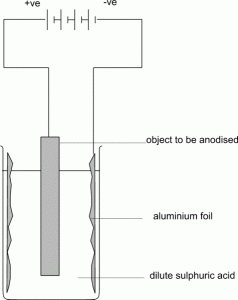The process of anodising is used to develop and increase the surface hardness, dielectric strength and wear resistance of metals, like titanium, aluminium and magnesium. Metals which have been anodised are also well set up for painting or colouring, with the anodising creating a stable but porous oxide layer which protects the metal.

What is anodising
Anodising is an oxidation process, much in the same way that steel corrodes into iron oxide, getting rusty in the process. When metals such as titanium or aluminium oxidise, they create stable compounds which strengthen the surface of the metal, with no chance of flaking or peeling.
To anodise metals, they are submerged into an acidic solution, with a voltage applied which helps to promote the absorption of oxygen into the surface of the metal. When anodising aluminium, the hard ceramic compound aluminium oxide is formed.
Methods of anodising
In the UK, there are three different methods of anodising that are used. The intended final use of the metal, as well as some other aspects are going to help make the choice over which method you should use.

Hard anodising
hard anodising creates a thick oxide layer of anything between 20 and 100 microns thick on the surface of the metal, depending on which of the base alloys you are using. This offers the largest increase in hardness, electrical resistance and wear resistance, providing a functional coating. Hard anodising is performed with a sulphuric acid solution, with high voltage, low temperature and high acid concentration.
Sulphuric acid anodising
Sulphuric acid anodising is the most commonly used form of anodising metal. A range of different thicknesses of coatings from 5 to 25 microns are possible when anodising aluminium, with a range of colouring treatments available. 10-15 micron thicknesses are required for effective colouring. Titanium can only be coated between 0.1 to 0.3 microns using this process.
Chromic acid anodising
This is by far the least commonly used of the anodising processes, but it is used for some key reasons. Chromic acid anodising is the preferred option when castings are being anodised, or if fatigue strength must not be reduced. The film thicknesses produced in chromic acid anodising are the thinnest, making it unsuitable for pieces which need to be coloured.
Considering the metal you wish to anodise, as well as the purpose of the piece should make your decision for you.
Keep reading asus rog maximus xi extreme


